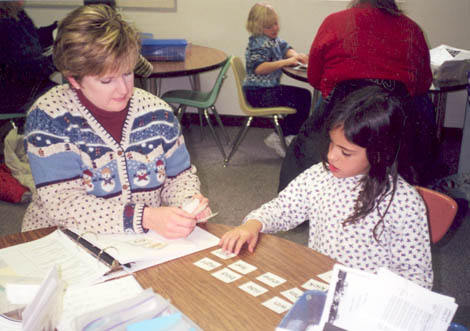At Home

| At Home Phonics | |
| Letter Names and Sounds | |
| Alphabet Sort | |
| High Frequency Words and Core Vowel Patterns | |
| Word Study | |
| At Home Phonics | |
How to Help Your Child on the Journey to Reading
Intervention is helpful, but your child will not make sufficient progress without significantly increasing the amount of reading that he or she does at school and at home. Therefore, your struggling reader needs to read, read, READ on instructional level at home - at least 20 minutes daily.
Whatever services parents secure for their child, they need to remember that intervention often is not sufficient for children to reach grade level expectations. Why? Struggling readers lack what researchers call a "practice effect" - improvement that comes from reading, reading, and more reading that happens outside of school hours. One study (Nagy & Anderson, 1987) showed that good readers consumed millions of words per year in text, while poor readers averaged only a fraction of that amount. In this sense, reading is like any other skill: limited practice leads to limited improvement.
So, the message is: even if your child is receiving intervention, (and ESPECIALLY if he or she is not currently receiving intervention) reading at home every day is critically important. And, at least 20 minutes of home reading time needs to be 'out loud' as you, or another skilled reader, listens and offers support as needed. Use the UURC's home reading charts to track progress.
In addition to listening to your child read aloud from previously unread text at his/her instructional level, we have three additional suggestions that you can access on your home computer.
- Help your child build fluency in connected text by conducting repeated readings at home. You can feel comfortable beginning this motivating, research-based form of fluency training when your child reaches a March Grade 1 (primer) reading level.
- Use the UURC's home word charts to help your child build fluency in grade-level text. Our word charts are designed for students in grades 1 through 8.
Even struggling readers enjoy competing against themselves to increase the number of words read and decrease their errors as they race against the clock in these two research-based activities!
- Finally, contact Sheree Nalwalker at the UURC (801-265-3951) to obtain a free subscription to Reading Horizons software. This motivating phonics program helps struggling readers increase word recognition and fluency and apply effective, efficient strategies in controlled text. For more information on these excellent at-home resources, go to http://athome.readinghorizons.com/find-a-reading-program.aspx. We thank the folks at Reading Horizon for making this opportunity possible! Availability is limited and assigned on a first-come/first served basis. (Kaisa will need your student's first and last name, grade in school, instructional reading level, and an email address for a parent.)
We know these aren't easy assignments because many struggling readers would rather clean a litter box than read at home. And after arguments and sometimes tears, most parents would rather ask their children to clean the litter box than to read. To make the situation as palatable as possible, our fluency suggestions are brief and motivating.
As for reading from text, home reading material should meet three conditions:
- Cell phones should be put away and the TV turned off.
- Your child should find the topic interesting.
- The text should be is on his/her instructional or independent level. A good rule of thumb here is that more than 1 error per every 10 words means the text is too hard.
Take turns reading every other page. Stop occasionally and talk about what's happening. When oral reading time is up, tell your child to read silently for another 15 minutes, and give a guiding question that you'll want answered (e.g., Why is Ron so mad at Harry?). Finally, fill out your child's UURC home reading chart. When it's complete bring it back to the clinic.
Resist the urge to "leave the reading to school and the clinic." Remember that your child is in a "race against time" to get enough practice to be able to cope with the increasing demands of more difficult text in later grades.
You Are Your Children's First Teacher! You have the power to help your children lay the foundation for successful reading. Although it may seem like an overwhelming responsibility, there is no need for apprehension. Ushering children into the "world of reading" can and should be done joyfully in a stress-free environment. Your children will take their "cues" about reading from you! The following link provides excellent suggestions: https://www.nytimes.com/guides/books/how-to-raise-a-reader

